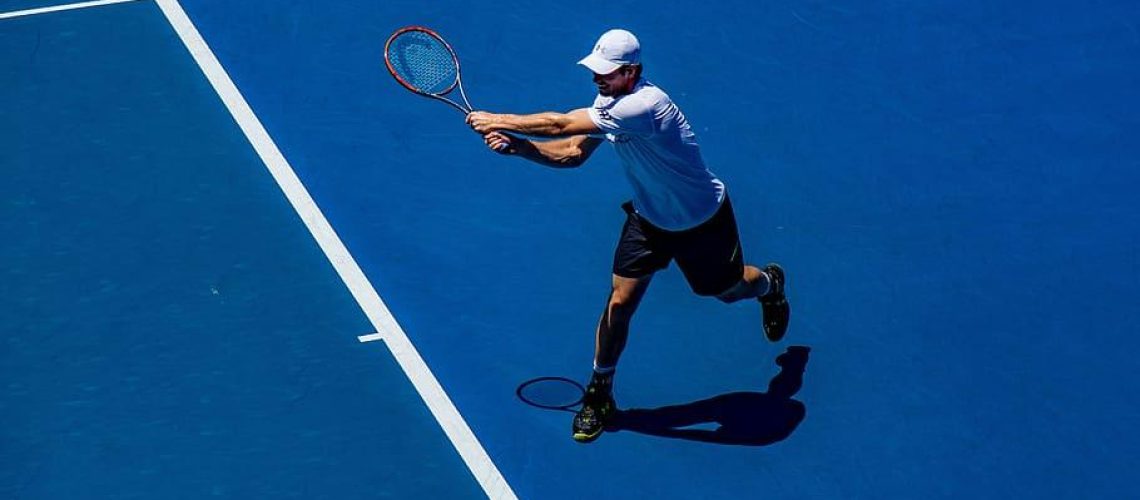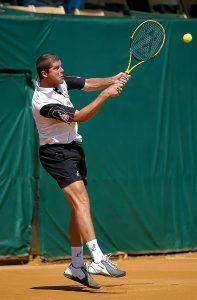We may earn money or products from the companies mentioned in this post.
Brief Overview of Tennis Courts and Their Importance in the Sport

Tennis, a sport enjoyed by millions around the world, is played on specially designed courts that provide the ideal playing surface for players to showcase their skills The dimensions of tennis courts have evolved over time, reflecting the sport’s rich history and the need for standardization
1 History of Tennis Court Dimensions
The origins of tennis can be traced back to 12th-century France, where it was initially played as a game called “jeu de paume” or “game of palm” The early courts were quite different from what we see today, often taking the shape of irregular rectangles or even L-shaped areas
As the game gained popularity across Europe, court dimensions started to take on more standardized forms In 1877, when Wimbledon became the first major tennis tournament in history, specific court measurements were introduced
2 Standardization of Court Sizes
To ensure fairness and consistency in competitive play, governing bodies such as the International Tennis Federation (ITF) have established regulations for court sizes These standards help maintain a level playing field and enable players to develop their skills within a consistent environment
Today, professional tennis courts are typically rectangular with specific lengths and widths The dimensions vary slightly between singles matches and doubles matches to accommodate different gameplay dynamics
Significance of Understanding Tennis Court Square Footage

Understanding the square footage of a tennis court is crucial for various reasons beyond just knowing its size Let’s explore two key factors:
1 Space Planning for Construction or Renovation Projects
Whether you’re building a new tennis facility or renovating an existing one, accurate knowledge of court square footage is essential This information helps architects, contractors, and facility managers plan the layout and allocate space efficiently
By understanding the square footage requirements, they can determine how many courts can fit within a given area, ensuring optimal use of available space Additionally, this knowledge aids in planning for spectator seating areas, walkways, and other necessary amenities
2 Determining Appropriate Surface Materials
Tennis courts can be constructed with various surface materials such as clay, grass, hard court (concrete or asphalt), or synthetic turf The square footage of the court plays a crucial role in determining which surface material is most suitable
For example, clay courts require more maintenance and tend to be larger than hard courts due to their slower playing speed Understanding the square footage allows facility owners and managers to choose the right surface material based on factors like maintenance costs, player preferences, and climate conditions
In conclusion,
the dimensions of tennis courts have evolved over time to reflect the sport’s history and standardization needs Understanding the square footage of tennis courts is crucial for effective space planning during construction or renovation projects and for determining appropriate surface materials that suit players’ needs and environmental factors By considering these aspects carefully, we can ensure optimal playing conditions for tennis enthusiasts worldwide
Tennis Court Dimensions and Square Footage

Official dimensions for different types of courts
When it comes to tennis court dimensions, there are specific measurements that need to be followed to ensure a fair and standardized playing surface Let’s take a look at the official dimensions for different types of courts
1 Singles tennis court dimensions and sq ft
A singles tennis court is slightly smaller than a doubles court, as it is designed for one-on-one matches The length of a singles court measures 78 feet, while the width is 27 feet To calculate the total square footage, simply multiply these two measurements together, resulting in a total area of 2,106 square feet
2 Doubles tennis court dimensions and sq ft
In comparison to a singles court, a doubles tennis court is wider to accommodate four players The length remains the same at 78 feet, but the width increases to 36 feet By multiplying these measurements together, we find that a doubles court has a total area of 2,808 square feet
Variations in court sizes based on level of play, age groups, or specific needs
While there are official dimensions for tennis courts, variations may exist depending on factors such as the level of play or specific requirements for certain age groups or tournaments
For example:
-
Junior Courts:
Tennis courts designed for younger players may have reduced dimensions to suit their abilities and physical capabilities -
Pickleball Conversion:
Some tennis courts can be converted into pickleball courts by using temporary lines without altering the overall size of the playing surface
In conclusion, understanding the dimensions and square footage of a tennis court is crucial for players, coaches, and organizers to ensure a fair and consistent playing experience Whether it’s singles or doubles, following the official measurements ensures that every aspect of the game remains intact However, flexibility in court sizes allows for customization based on specific needs or age groups
Factors Influencing Tennis Court Size and Layout

When it comes to designing a tennis court, several factors come into play to determine the size and layout These considerations ensure that the court meets the specific needs of its purpose and location
Purpose and Location Considerations
One important factor is whether the court will be used for private residential purposes or as part of a public facility Private residential courts often have more flexibility in terms of size and layout, while public facilities need to accommodate larger numbers of players
Another consideration is whether the court will be indoor or outdoor Indoor courts require additional space for building structures, while outdoor courts must consider factors like weather conditions and sun exposure
Accessibility Requirements
Tennis courts should be accessible to all individuals, regardless of their physical abilities Wheelchair accessibility specifications include features such as ramps, appropriate surface textures, and ample maneuvering space around the court
In addition to wheelchair accessibility, accommodations for visually impaired players are also important These may include audible cues or tactile markings on the court surface to assist blind or visually impaired players during gameplay
Additional Space Requirements Surrounding the Court

Run-off Space for Safe Play
To ensure safe play, tennis courts require sufficient run-off space surrounding the playing area Recommended distances from baselines and sidelines to fences or walls help prevent injuries caused by collisions with surrounding structures
The impact on overall required square footage for construction projects should also be considered when planning new tennis facilities or renovating existing ones Proper spacing ensures that players can move freely without feeling cramped or restricted during matches
Spectator Seating Options
An essential aspect of any tennis court design is providing seating options for spectators The choice between bleacher-style seating and individual seats or benches depends on the desired atmosphere and capacity of the facility
Additionally, appropriate spacing between rows is crucial to ensure an optimal viewing experience for spectators Sufficient legroom and unobstructed sightlines contribute to a comfortable and enjoyable time spent watching tennis matches
Other Facilities Commonly Found Near Tennis Courts
Tennis facilities often include other amenities to enhance the overall experience for players and visitors These may include locker rooms, restrooms, pro shops, or even cafeterias or lounges for post-match relaxation
Having these additional facilities nearby ensures convenience and makes tennis courts more welcoming spaces where players can fully enjoy their time on and off the court
Useful Links

Tennis court dimensions and Layout – A Beginner’s Guide
Tennis Court Dimensions – The Resource Nexus
Tennis Court Dimensions: How Big is a …
Tennis Court Dimensions: The Ultimate Guide – VMKONSPORT
Ultimate Guide to Tennis Court Dimensions
How Many Padel Courts Can Fit On A Tennis Court?
Tennis Court Dimensions
How much space do you need for a tennis court?
How many square feet on a tennis court?
Exactly how big is a tennis court?
How Many Square Feet Is A Tennis Court
Padel Court Dimensions Guide
DIY Tennis Court: Your Next Project?
Custom Sized Gym Floors | Basketball Court Flooring
Tennis Court Size And Dimensions
Tennis Court Dimensions In Feet & Some Measurement Tips
How Much Does a Tennis Court Cost?
How much does it cost to build a tennis court?
Tennis Court Paint | 6 Courts
TCS Coatings Material Estimator






